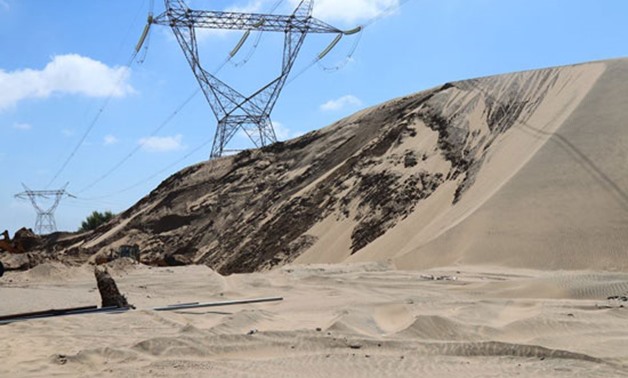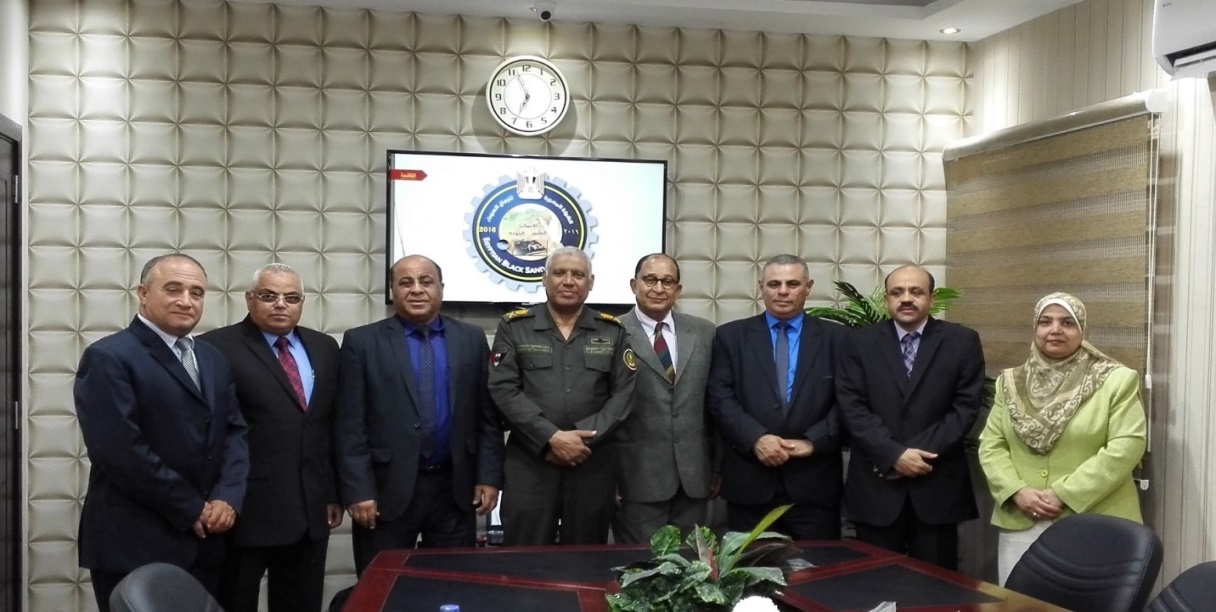CAIRO - 19 October 2022: As it flows from the great rivers region through to the Mediterranean Sea, The Nile River sweeps some minerals to the Arab world, in a process transferring these minerals to sea beaches and forming black dunes.
Named after its color, black sand contains a percentage of essential minerals: ilmenite, zircon, magnetite, rutile, garnet, as well as monazite, which contains radioactive minerals. Of significant economic importance, Black sand is also beneficial for the environment.
In Egypt, black sand is available on the coast overlooking the Mediterranean Sea from Rasheed to Rafah with a length of 400 km. It is spread by sea currents and waves in those areas and present in the sand dunes.
Recognizing its importance, Egypt inaugurated Wednesday, Oct. 19, Black Sand plant complex in El-Burullus city, Kafr El-Sheikh governorate. This came years after the state established the Egyptian Black Sand Company in 2016 and in turn, the foundation stone for a black sand separation plant in El-Burullus was laid in 2018 on an area of 80 acres in Kafr El-Sheikh, with investments exceeding LE 1 billion.
The Black Sand plant in Kafr El-Sheikh is the first of its kind in the world, with the most advanced mining equipment, Presidential Spokesman Bassam Rady stated.
Rady added that the plant will be part of mega national projects which aim to optimize the use of Egypt's natural resources and attain added value of minerals extracted from black sand.
Currently, the state is reviving the black sand project with the participation of the National Service Projects Organization of the Armed Forces, the Nuclear Materials Authority and the National Investment Bank, in addition to two factories, one of them is an Australian-Egyptian in East Burullus and the other is Chinese in the north of El-Burullus.
Black Sand Importance
The importance of black sand was first discovered at the end of the 1980s and the beginning of the 1990s, proved by a feasibility study of the sand and how to best utilize it, conducted by the international Australian Office.
According to an aerial survey carried out by the Nuclear Materials Authority, Egypt has 11 sites of black sand along the northern coast. Studies and researches have revealed that the geological reserve of those sands on the Egyptian coast reaches about 1.3 billion cubic meters, including Rasheed area, with re- serves of 600 million cubic meters, Damietta area with a reserve of 300 million cubic meters, and Arish Rafah area with 200 million cubic meters.
Mineral reserves in Egyptian black sands are estimated at 285 million tons, containing an average capacity of 3.4 percent of heavy metals with a distance of about 22 km, in the western sec- tor which lies east of El-Burullus. There are also proven mineral reserves in the eastern sector, worth about 48 million tons containing an average capacity of 2.1 percent of heavy metals, as well as the future supply of black sand.
The black sand in these areas contains eight types of heavy metals, ranging in composition between 1 percent and 8 percent.
A feasibility study by Roche Company argues that the economic return from merely one of the 11 sites will lead to over LE 255 million annually. Exploitation of these minerals provides Egypt with millions of dollars, which would be spent on importing only one of these metals, such as zinc, one of the key elements in Egypt’s famous ceramic industry, in addition to other metals, including iron, granite, monazite and titanium metal utilized in the manufacture of bodies of aircraft, submarines and rail bars.
.png)
Map of northern part of Egypt showing the black sand deposits (dotted coastal strip) and the study sites location in Abu Khashaba and Baltim - photo courtesy of ResearchGate
Black sand contains elements and minerals, such as almnjanet; radioactive elements; and titanium metal, which is extracted from high-quality alalimat and rutile, then used in the manufacture of paints and coatings, plastics and rubber, ceramics, cosmetics, leather, pharmaceuticals. It also contains metal zircon, which is used in the manufacture of ceramics, glass hearts, nuclear reactors and car motors, in addition to metal granite used in the manufacture of water filters and paints. Also, almajnti ore is used in the manufacture of sponge iron and cast iron.
According to an official source, Rashid has the largest reserves of black sand, with 500 million cubic meters, pointing out that the Egyptian sand deposits represent the largest reserves in the world, as they spread along areas on the Mediterranean coast.
Former media advisor of the Egyptian President Ahmed El Meslmani previously said in a TV interview that Egypt and Saudi Arabia are major Arab countries with black sands, adding that Egypt has the largest reserves in the world of minerals found in black sand, estimated at more than one billion cubic meters. Meslmani explained that black sand contains about 41 very expensive metals used in many industries, such as the rocket industry, aircraft industry, ceramics, paints and nuclear radiation materials.
Official Steps
Endeavoring to combat theft scenes, the Egyptian Parliament approved in 2019 a draft law authorizing cooperation between the Ministry of Electricity and specialized local bodies to benefit from Egypt’s black sand and extract a number of economic minerals, considering it a solid investment in renewable energy.
The draft law, sent by the cabinet and approved by the parliament, allows cooperation between the ministry, the Cairo-based Nuclear Materials Authority and the Egyptian Black Sand Company (EBSC).
Moreover, the Armed Forces have signed a contract with the Egyptian Black Sand Company in May 2018 to start a project separating economic minerals from black sand in Egypt. The latter is working to achieve maximum profitability in the extraction of heavy minerals with a strategy to streamline the export of raw materials and the rationalization of import products, both inter- mediate and final, and to highlight the added value of mineral ores.
In 2019, Minister of Electricity and Renewable Energy Mohamed Shaker inaugurated the first phase of a black sand mining project at Rasheed Beach, to become the first production line of black sand.
Head of the Egyptian Nuclear Materials Authority Hamed Mira stated that the first phase consists of three units for extraction and concentration, in addition to two magnetic sepa- ration units with an annual output capacity of 31,000 tons.
The Rashid Beach area is the second region in Egypt where the extraction process has taken place, after the coast of Baltim in Kafr el-Sheikh.
“The Nuclear Materials Authority, the Kafr El-Sheikh governorate and several major companies are cooperating to invest in Egyptian minerals,” former Consultant to the Governor of Kafr el-Sheikh for Development and In- vestment Khaled Dosoky tells Business Today Egypt.
“Minerals in the sand are raw metals that have little economic value, so they will be extracted and build an extra element from them to hit three or four times the price of raw minerals,” Desoky clarifies.

.png)

Comments
Leave a Comment